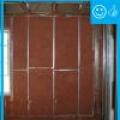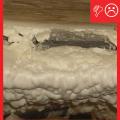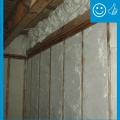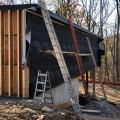Scope
Install ceiling, wall, and foundation insulation that meets or exceeds the requirements of the most recent International Energy Conservation Code adopted by your state or municipality. If you are pursuing ENERGY STAR or DOE Zero Energy Ready Home certification, follow the version and revision requirements relevant to your state. See ENERGY STAR National Program Requirements webpage for a current table of versions required for each U.S. state and territory and adoption dates based on home permit dates.
- The DOE Zero Energy Ready Home Program, Version 07, requires homes to meet or exceed 2015 IECC insulation levels.
- DOE Zero Energy Ready Home National Program Requirements Revision 07 are required for homes permitted starting 06/01/2019. Homes started before 06/01/2019 but on or after 07/20/2017 may use either the Revision 06 or Revision 07 requirements.
- The ENERGY STAR Single-Family New Homes Program Version 3.0, Revision 11 requires that ceiling, wall, floor, and slab insulation levels meet or exceed those specified in the 2009 International Energy Conservation Code (IECC) with some alternatives and exceptions. States that have adopted IECC 2012, 2015, or 2018 must meet the requirements of ENERGY STAR Single-Family New Homes Version 3.1, which specifies that homes meet or exceed 2012 IECC insulation levels.
See the Compliance Tab for links to related codes and standards and voluntary federal energy-efficiency program requirements.
Description
The U.S. Department of Energy Zero Energy Ready Home Program specifies that all certified homes should meet the mandatory requirements listed in Exhibit 1 of the DOE Zero Energy Ready Home National Program Requirements. Item 2.2 in the mandatory requirements requires that “ceiling, wall, floor, and slab insulation shall meet or exceed 2015 IECC levels.”
The minimum insulation requirements for ceilings, walls, floors, and foundations in new homes, as listed in the 2015 IECC can be found on the Compliance Tab of this guide.
The DOE Zero Energy Ready Home program includes two paths: the prescriptive path and the performance path.
How to follow the DOE Zero Energy Ready Home Prescriptive Path for 2015 IECC Insulation Levels
First determine whether you are eligible to use the prescriptive path, as described in the DOE Zero Energy Ready Home National Program Requirements. Eligibility is based on the number of bedrooms and overall square footage of the home; larger homes typically must use the performance path. If you are eligible to use the prescriptive requirements and choose to use this method, construct your home following the mandatory requirements of Exhibit 1 as well as the requirements of Exhibit 2. Both lists stipulate that insulation levels should meet or exceed 2015 IECC levels as listed in Table R402.1.1, with the following notes and exceptions:
- Steel-frame ceilings, walls, and floors shall meet the insulation requirements of the 2015 IECC – Table 402.2.6.
- For ceilings with attic spaces, R-30 shall satisfy the requirement for R-38 and R-38 shall satisfy the requirement for R-49 wherever the full height of uncompressed insulation at the lower R-value extends over the wall top plate at the eaves. This exemption shall not apply if the alternative calculations in d) are used;
- For ceilings without attic spaces, R-30 shall satisfy the requirement for any required value above R-30 if the design of the roof / ceiling assembly does not provide sufficient space for the required insulation value. This exemption shall be limited to 500 sq. ft. or 20% of the total insulated ceiling area, whichever is less. This exemption shall not apply if the alternative calculations in d) are used;
- An alternative equivalent U-factor or total UA calculation may also be used to demonstrate compliance, as follows: An assembly with a U-factor equal to or less than specified in 2015 IECC Table 402.1.3 complies. A total building thermal envelope UA that is less than or equal to the total UA resulting from the U-factors in Table 402.1.3 also complies. The insulation levels of fenestration, ceilings, walls, floors, and slabs can be traded off using the UA approach under both the Prescriptive and the Performance Path. Also, note that while ceiling and slab insulation can be included in trade-off calculations, Items 4.1 through 4.3 of the ENERGY STAR for Homes V3 Thermal Enclosure System Rater Checklist shall be met regardless of the UA tradeoffs calculated. The UA calculation shall be done using a method consistent with the ASHRAE Handbook of Fundamentals and shall include the thermal bridging effects of framing materials. The calculation for a steel-frame envelope assembly shall use the ASHRAE zone method or a method providing equivalent results, and not a series-parallel path calculation method.
How to follow the DOE Zero Energy Ready Home Performance Path for 2015 IECC Insulation Levels
Builders following the Zero Energy Ready Home performance path must meet all of the mandatory requirements in Exhibit 1 and must also meet or exceed the overall HERS Index score generated for their home by modeling software, as defined by Exhibit 2. To determine a target HERS index, the home, as designed, is modeled using the requirements listed in Exhibit 1 and 2. The software creates a target HERS index based on the climate, HVAC, and water heating equipment selected, and other specifics about the home.
Exhibit 2 sets insulation target levels and requires builders to meet the 2015 IECC and achieve Grade 1 installation, per RESNET standards. For more on RESNET Grade 1 insulation installation, see Insulation Installation (RESNET Grade 1).
Success
Insulation installation should be inspected by site supervisors before drywall is installed to confirm that specified amounts of insulation have been installed and that installation meets RESNET Grade 1 standards. It is important to consult the insulation requirements of the 2015 International Energy Conservation Code (IECC) to ensure the R-value (or U-value) requirements are met or exceeded. A table of these R-value requirements is provided in the Compliance Tab. Be sure to review the exceptions listed for ceilings as these can affect the required insulation levels.
Typical R-values for common insulation materials are summarized in this table, which also identifies the vapor retarder classification for each insulation.
Climate
The map in Figure 1 shows the climate zones for states that have adopted energy codes equivalent to the International Energy Conservation Code (IECC) 2009, 2012, 2015, and 2018. The map in Figure 2 shows the climate zones for states that have adopted energy codes equivalent to the IECC 2021. Climate zone-specific requirements specified in the IECC are shown in the Compliance Tab of this guide.


Training
Compliance
More
More Info.
Access to some references may require purchase from the publisher. While we continually update our database, links may have changed since posting. Please contact our webmaster if you find broken links.
Sales
High-R Insulation = High-Efficiency or Ultra-Efficient Insulation
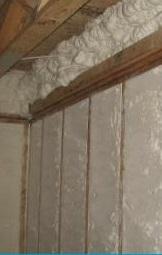
There are two levels of insulation: high-efficiency insulation, which meets the 2015 International Energy Conservation Code, and ultra-efficient insulation, which is 25% more efficient than this national code. Using high-efficiency and ultra-efficient insulation along with professional installation (e.g., no gaps, voids, compression, or misalignment with air barriers; complete air barriers; and minimal thermal bridging) creates conditioned spaces that require very little heating and cooling, along with, even comfort and quiet throughout the house.





